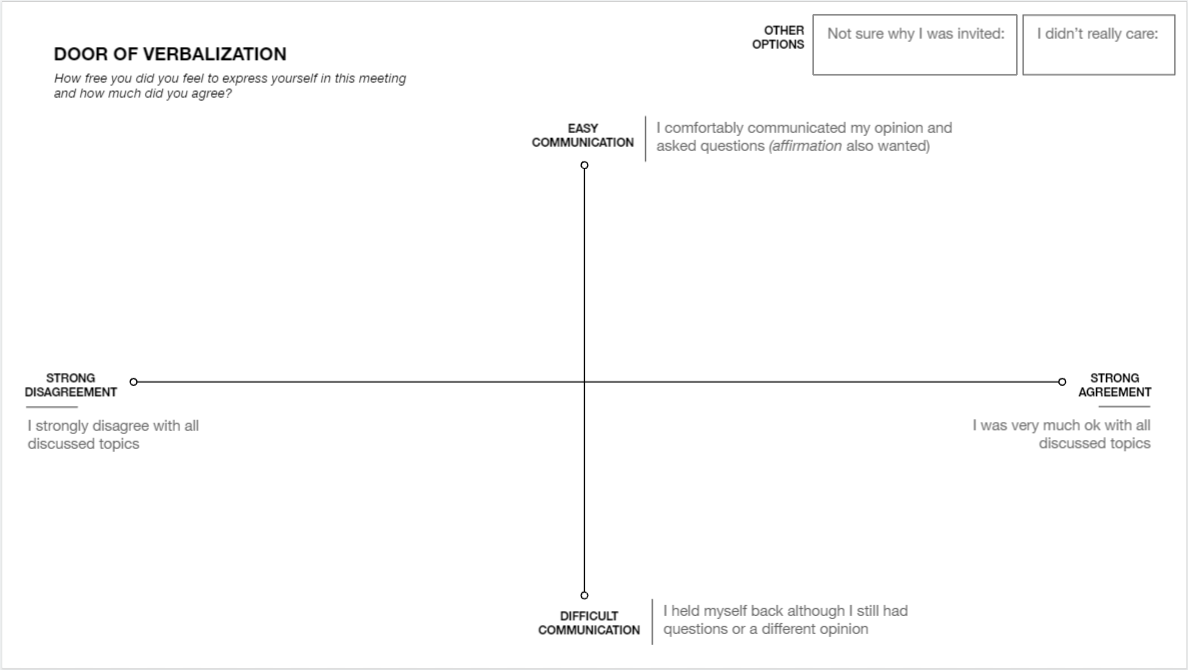Door of Verbalization
A new tool to capture level of agreement and ease of communication for meetings
What is the purpose of this tool?
While I was moderating a Retrospective for a group of leads they were discussing how important they found that everyone feels free to speak up in a meeting and that they want attendees to feel safe to ask questions, because they believe there is no such thing as stupid questions. Another point in the same Retro session was that in larger group meetings, especially in remote ones, it's hard to see the level of agreement of everyone and the extent of participation, because often people aren't aware that a thumbs-up via camera will help the driver of the discussion getting an overview. Important clues like body language can hardly be noticed. This was how the Door of Verbalization (DoV) came to life.
The DoV will give you the chance to collect more insight after a meeting with a group of people. It will help you gather how much everyone was agreeing, and also how free the attendees had actually felt to speak up.
By attaining information on these two factors you have the opportunity to find out, if attendees are disagreeing and why and if there is the need to further nourish their engagement and learn how to empower them to speak up.
At the end of the day employees that agree with what's being done at work and that are more engaged are more motivated employees. This in return will result in better products and services for the customers.
When to use this tool?
The Door of Verbalization works best in a group of >= 5 attendees. They can be either from the same or from different teams.
In the latter case, providing a safe space, e.g. by collecting feedback anonymously, will be crucial.
The DoV has potential for greater rounds to reveal the overall opinion, e.g. department All Hands or team meetings. Especially for recurring meetings it will provide a health check that can be observed over time.
How does it work?
In the last 5 minutes of your meeting, ask the attendees to express their level of agreement and ease to speak.

There are 2 scales embedded in this format.
The y-axis of the graph is used to give feedback on ease of communication
The x-axis is used to indicate the level of overall agreement
So everyone puts a dot on the graph where they find it most fitting to their view.
Additional indicators:
Sometimes people might not be directly concerned, but somehow got invited or ended up in the meeting and their attendance isn't needed. "I'm not sure why I was invited" is the indicator that they could be skipped in the next invite. Or they can be aligned with how the meeting should be better utilized to improve value for all parties.
Others might be lacking engagement. "I didn't really care" is the other option to pick. These feedbacks especially need follow-up questions to check how to improve engagement or value of attendance.
If you use the DoV for recurring meetings, you first present the result from the last time and inform the attendees about the follow-ups and measures that have resulted from the last round. This way everyone has the chance to also give feedback on them.
Medium:
As we're in a remote situation, the challenge is to provide a space that feels safe to share feedback in.
If you're confident your group is not afraid to share, you can tackle this interactively on a presentation slide, via an online interactive whiteboard or other collaboration tool where it will be visible who made which change. There you could use the setup depicted above.
One alternative is to collect the feedback via an anonymous Google form. Slido polls can also be the tool of choice, but will not enable connecting the data points for both scales.
What else is needed?
Solely collecting the dots will not help you move forward, so you will need a part two to ask your audience to give more concrete feedback, by collecting hints to what was missing. Completing questions you can ask:
For higher agreement & engagement:
On which meeting topic/s do you need more information or have open questions?
What concerns do you have or challenges do you see regarding which topic/s?
On which topics did you mentally sign off and what is the reason for that?
For encouraging to speak up, voice opinions:
- What do you need to feel more comfortable to ask questions / give feedback?
And as with every time when feedback is being collected, following up is essential.



